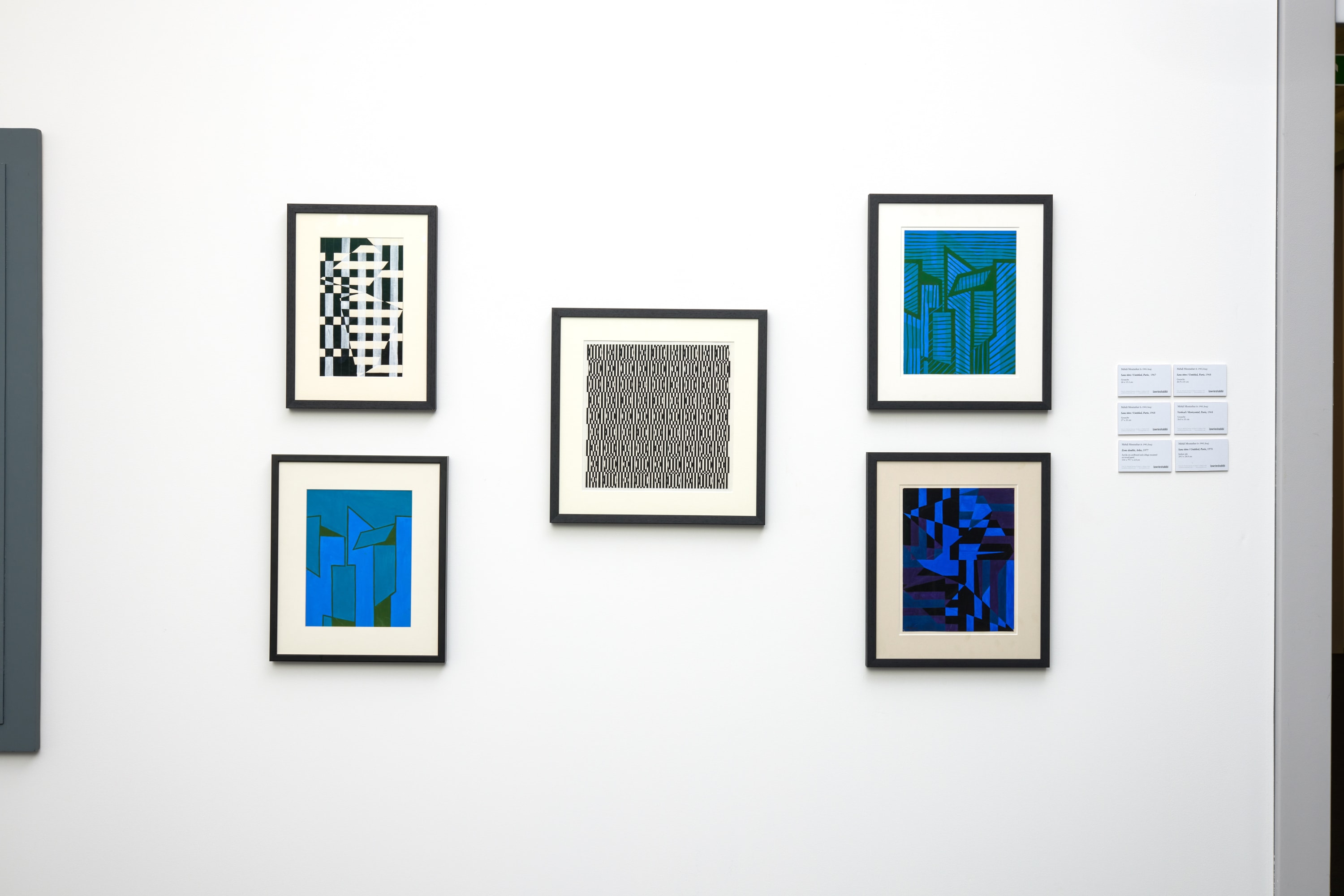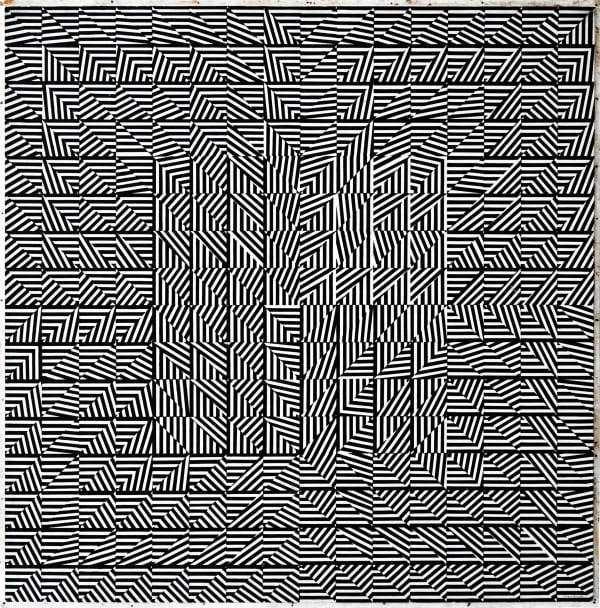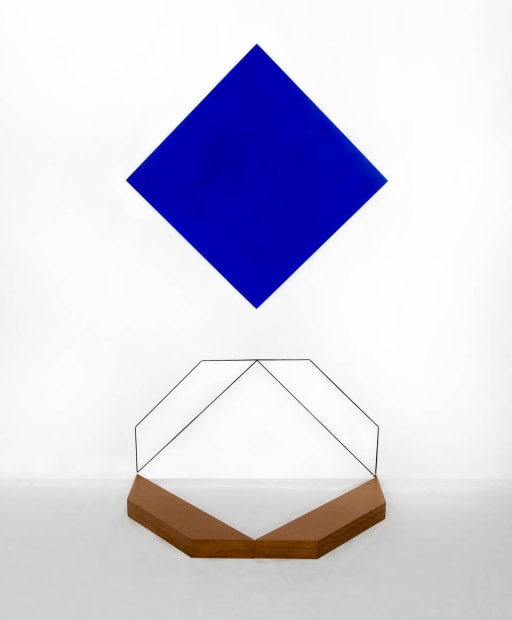-
Mehdi Moutashar
IN FOCUS
-
Mehdi Moutashar (b. 1943, Iraq) is a pioneering modern artist known for his experimentation with geometry and line.
In conjunction with the artist's solo exhibition at Mathaf, Lawrie Shabibi invites you to explore an online survey of Mehdi Moutashar’s practice spanning from the 1960s to the present.
-
 Mehdi Moutashar, Trois Angles à 135° (Three Angles at 135° ), Nicknamed "The Spider", 2005, Wood and painted wood, elastic wire, 114 x 729 x 555 cm.
Mehdi Moutashar, Trois Angles à 135° (Three Angles at 135° ), Nicknamed "The Spider", 2005, Wood and painted wood, elastic wire, 114 x 729 x 555 cm.Mehdi Moutashar
(b. 1943, Iraq)Mehdi Moutashar spent most of his artistic life in his chosen home France, where he moved to in 1967. Very early on, his practice embraced the hard-edge abstraction and Op-Art movements of the 1960’s, becoming part of the roster of the legendary Denis René Gallery in Paris, renowned for her geometric and kinetic art programme, where he exhibited alongside artists such as Francois Morellet, Julio Le Park, Viktor Vaserelly and Carlos Cruz Diez. At the same time, he never lost sight of his innate Iraqi, Babylonian and Islamic art influences and was guided by their mathematical and geometric investigations as well as their early methods and systems. In recognition of the “contemporary relevance of his work” and ability to demonstrate a “profound understanding of the cultures from which he comes” he was a joint winner of the Jameel Prize 5 (2018).
His work establishes a profound connection with the viewer's physical presence and the surrounding space. It references the elegant symmetry of traditional Iraqi brickwork and the captivating cobalt tiles discovered in Babylonian ruins and draws inspiration from the intricate adornments of local shrines. The gestural lines in his sculptures evoke the dynamic energy found in Arabic calligraphy, although they are actually derived from an enormous interlaced pattern that the artist has been experimenting with for decades.
-

-
Frieze Masters 2023
SpotlightLawrie Shabibi's Frieze Masters presentation featured paintings and drawings that revealed Mehdi Moutashar's early experimentations with the language of geometry creating radical and innovative visual solutions. Very few of these works remain with the artist: on 4th December 2003 the town of Arles suffered a catastrophic flood that destroyed the majority of his 20th century paintings. The few remaining pieces tracing his journey of discovery from 1967-1979 were exhibited at Frieze Masters. Of note are two important works: Zone 1, 1969, his first ‘square’ painting and Deux rectangles dont un pivoté de 15°, 1979. -
"The world in which Mehdi Moutashar's works develop is more one of angles, folds and interstices than one of pedestals, frames and curtains. To put it more bluntly, the artist is more concerned with voids than with solids and, even more specifically, he shows a preference for the points where the visible is afoot, woven on the visible itself. "
— Morad Montazami, art historian, curator.
-
 Mehdi Moutashar, Deux carrés dont un encadré (Two squares, One Framed), 2017, Wood, paint, elastic wire. One of the four minimalist geometric artworks part of Moutashar's Jameel Prize 5 presentation. Courtesy the Artist, V&A London and Art Jameel. Photo © Fabrice Leroux
Mehdi Moutashar, Deux carrés dont un encadré (Two squares, One Framed), 2017, Wood, paint, elastic wire. One of the four minimalist geometric artworks part of Moutashar's Jameel Prize 5 presentation. Courtesy the Artist, V&A London and Art Jameel. Photo © Fabrice Leroux -
-
“I discovered this liberty to examine, to make questions. I don’t believe it’s necessary to find the definite answer - there is no definite answer in fact. I have to question everything, to question everything in my mind and myself and my history. In this way I feel that I am alive."
— Mehdi Moutashar, excerpt from an interview with Victoria and Albert Museum.
-
-
 Mehdi Moutashar, Eleven Squares, 2016, Cardboard model, 26,5 × 40 × 42 cm. Final dimensions : 225 × 345 × 333 cm
Mehdi Moutashar, Eleven Squares, 2016, Cardboard model, 26,5 × 40 × 42 cm. Final dimensions : 225 × 345 × 333 cm -
 Eight Squares, 1986. Sketch, pencil on paper. Courtesy of the artist.The origin of this model goes back to a drawing made in the late ‘80s; a sketch – which the artist immediately made several versions of – that filtered through in the studio, like the beginning of an answer to the question of the hour.More than once, the preliminary stages in a research process, which are immediately perceived as bearers of something both important and utterly elusive, remain withdrawn and on hold for a long time, amidst many other fragments, until they are suddenly met with the proper conditions in which they are able to flourish. Parallel to all of these pieces relating to the figure of the magic square, of which multiple iterations were made during the ‘80s, particularly in the form of installations based on modules, were four clay or wooden bricks surrounding an empty and of course square space. The question that faced an artist whom nothing fascinated more than the limitless unfurling of possibilities was this: how does one introduce movement into this archetype of orthogonal stability?The solution was to keep two of the axes – vertical and horizontal – as two baselines, to not change the proportions of the double squares, and to divide the right angle into three: into two obliques rotated at a 30-degree angle, which shift mathematically from one footing to the other and in doing so drive the overall piece into the general movement. While it stayed vibrant in the background, this drawing remained undeveloped for over thirty years before it was actualized in 2016 in a large-scale construction project entitled Eleven Squares, the angles and folds of which open out far from the walls, showing the viewer an unexpected succession of points of view. As of yet, the project has not been developed further than a model.
Eight Squares, 1986. Sketch, pencil on paper. Courtesy of the artist.The origin of this model goes back to a drawing made in the late ‘80s; a sketch – which the artist immediately made several versions of – that filtered through in the studio, like the beginning of an answer to the question of the hour.More than once, the preliminary stages in a research process, which are immediately perceived as bearers of something both important and utterly elusive, remain withdrawn and on hold for a long time, amidst many other fragments, until they are suddenly met with the proper conditions in which they are able to flourish. Parallel to all of these pieces relating to the figure of the magic square, of which multiple iterations were made during the ‘80s, particularly in the form of installations based on modules, were four clay or wooden bricks surrounding an empty and of course square space. The question that faced an artist whom nothing fascinated more than the limitless unfurling of possibilities was this: how does one introduce movement into this archetype of orthogonal stability?The solution was to keep two of the axes – vertical and horizontal – as two baselines, to not change the proportions of the double squares, and to divide the right angle into three: into two obliques rotated at a 30-degree angle, which shift mathematically from one footing to the other and in doing so drive the overall piece into the general movement. While it stayed vibrant in the background, this drawing remained undeveloped for over thirty years before it was actualized in 2016 in a large-scale construction project entitled Eleven Squares, the angles and folds of which open out far from the walls, showing the viewer an unexpected succession of points of view. As of yet, the project has not been developed further than a model. -
 Still from interview with Victoria and Albert Museum for the Jameel Prize 5, 2018.
Still from interview with Victoria and Albert Museum for the Jameel Prize 5, 2018. -

-
 Mehdi Moutashar, Trois Plis à 60° et Deux Carrés (Three Folds at 60° and Two Squares), 2021, Painted wood, painted steel, elastic wire, 141 x 191 cm 55 51/100 x 75 1/5 in.
Mehdi Moutashar, Trois Plis à 60° et Deux Carrés (Three Folds at 60° and Two Squares), 2021, Painted wood, painted steel, elastic wire, 141 x 191 cm 55 51/100 x 75 1/5 in.






















